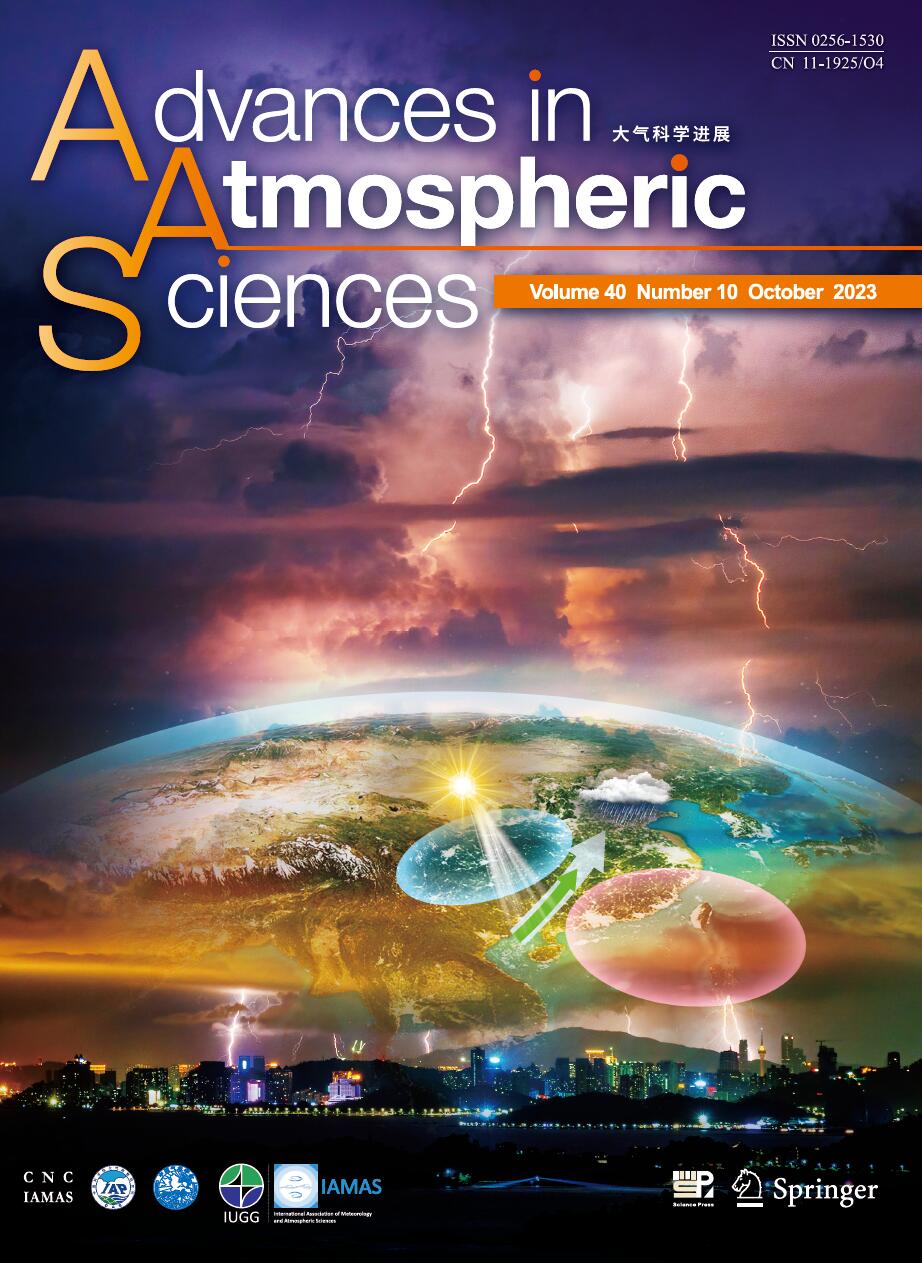| [1] |
Jing YANG, Gaopeng LU, Ningyu LIU, Haihua CUI, Yu WANG, Morris COHEN,
2017: Analysis of a Mesoscale Convective System that Produced a Single Sprite, ADVANCES IN ATMOSPHERIC SCIENCES, 34, 258-271.
doi: 10.1007/s00376-016-6092-0
|
| [2] |
LIU Dongxia, QIE Xiushu, XIONG Yajun, FENG Guili,
2011: Evolution of the Total Lightning Activity in a Leading-Line and Trailing Stratiform Mesoscale Convective System over Beijing, ADVANCES IN ATMOSPHERIC SCIENCES, 28, 866-878.
doi: 10.1007/s00376-010-0001-8
|
| [3] |
LIPING LUO, Ming Xue, Xin Xu, Lijuan Li, Qiang Zhang, Ziqi Fan,
2024: Understanding Simulated Causes of Damaging Surface Winds in a Derecho-Producing Mesoscale Convective System near the East China Coast based on Convection-Permitting Simulations, ADVANCES IN ATMOSPHERIC SCIENCES.
doi: 10.1007/s00376-024-3314-8
|
| [4] |
SUN Jianhua, ZHAO Sixiong, XU Guangkuo, MENG Qingtao,
2010: Study on a Mesoscale Convective Vortex Causing Heavy Rainfall during the Mei-yu Season in 2003, ADVANCES IN ATMOSPHERIC SCIENCES, 27, 1193-1209.
doi: 10.1007/s00376-009-9156-6
|
| [5] |
Zhiwei HE, Qinghong ZHANG, Jun SUN,
2016: The Contribution of Mesoscale Convective Systems to Intense Hourly Precipitation Events during the Warm Seasons over Central East China, ADVANCES IN ATMOSPHERIC SCIENCES, 33, 1233-1239.
doi: 10.1007/s00376-016-6034-x
|
| [6] |
CHU Kekuan, TAN Zhemin, Ming XUE,
2007: Impact of 4DVAR Assimilation of Rainfall Data on the Simulation of Mesoscale Precipitation Systems in a Mei-yu Heavy Rainfall Event, ADVANCES IN ATMOSPHERIC SCIENCES, 24, 281-300.
doi: 10.1007/s00376-007-0281-9
|
| [7] |
ZHAO Sixiong, BEI Naifang, SUN Jianhua,
2007: Mesoscale Analysis of a Heavy Rainfall Event over Hong Kong During a Pre-rainy Season in South China, ADVANCES IN ATMOSPHERIC SCIENCES, 24, 555-572.
doi: 10.1007/s00376-007-0555-2
|
| [8] |
Changhai LIU,
2005: A Numerical Investigation of a Slow-Moving Convective Line in a Weakly Sheared Environment, ADVANCES IN ATMOSPHERIC SCIENCES, 22, 625-639.
doi: 10.1007/BF02918706
|
| [9] |
Yali LUO, Weimiao QIAN, Yu GONG, Hongyan WANG, Da-Lin ZHANG,
2016: Ground-Based Radar Reflectivity Mosaic of Mei-yu Precipitation Systems over the Yangtze River-Huaihe River Basins, ADVANCES IN ATMOSPHERIC SCIENCES, 33, 1285-1296.
doi: 10.1007/s00376-016-6022-1
|
| [10] |
Ji-Hyun HA, Hyung-Woo KIM, Dong-Kyou LEE,
2011: Observation and Numerical Simulations with Radar and Surface Data Assimilation for Heavy Rainfall over Central Korea, ADVANCES IN ATMOSPHERIC SCIENCES, 28, 573-590.
doi: 10.1007/s00376-010-0035-y
|
| [11] |
Fan Beifen, Ye Jiadong, William R. Cotton, Gregory J. Tripoli,
1990: Numerical Simulation of Microphysics in Meso-β-Scale Convective Cloud System Associated with a Mesoscale Convective Complex, ADVANCES IN ATMOSPHERIC SCIENCES, 7, 154-170.
doi: 10.1007/BF02919153
|
| [12] |
ZHU Guofu, CHEN Shoujun,
2003: A Numerical Case Study on a Mesoscale Convective System over the Qinghai-Xizang (Tibetan) Plateau, ADVANCES IN ATMOSPHERIC SCIENCES, 20, 385-397.
doi: 10.1007/BF02690797
|
| [13] |
Anjing HUANG, Gaopeng LU, Hongbo ZHANG, Feifan LIU, Yanfeng FAN, Baoyou ZHU, Jing YANG, Zhichao WANG,
2018: Locating Parent Lightning Strokes of Sprites Observed over a Mesoscale Convective System in Shandong Province, China, ADVANCES IN ATMOSPHERIC SCIENCES, 35, 1396-1414.
doi: 10.1007/s00376-018-7306-4
|
| [14] |
WANG Xiaokang, NI Yunqi, XU Wenhui, GU Chunli, QIU Xuexing,
2011: Water Cycle and Microphysical Processes Associated with a Mesoscale Convective Vortex System in the Dabie Mountain Area, ADVANCES IN ATMOSPHERIC SCIENCES, 28, 1405-1422.
doi: 10.1007/s00376-011-0089-5
|
| [15] |
Honglei ZHANG, Ming XUE, Hangfeng SHEN, Xiaofan LI, Guoqing ZHAI,
2024: Local Torrential Rainfall Event within a Mei-Yu Season Mesoscale Convective System: Importance of Back-Building Processes, ADVANCES IN ATMOSPHERIC SCIENCES, 41, 847-863.
doi: 10.1007/s00376-023-3033-6
|
| [16] |
Jo-Han LEE, Dong-Kyou LEE, Hyun-Ha LEE, Yonghan CHOI, Hyung-Woo KIM,
2010: Radar Data Assimilation for the Simulation of Mesoscale Convective Systems, ADVANCES IN ATMOSPHERIC SCIENCES, 27, 1025-1042.
doi: 10.1007/s00376-010-9162-8
|
| [17] |
WANG Qiwei, TAN Zhemin,
2009: Idealized Numerical Simulation Study of the Potential Vorticity Banners over a Mesoscale Mountain: Dry Adiabatic Process, ADVANCES IN ATMOSPHERIC SCIENCES, 26, 906-922.
doi: 10.1007/s00376-009-8004-z
|
| [18] |
Na LI, Lingkun RAN, Linna ZHANG, Shouting GAO,
2017: Potential Deformation and Its Application to the Diagnosis of Heavy Precipitation in Mesoscale Convective Systems, ADVANCES IN ATMOSPHERIC SCIENCES, 34, 894-908.
doi: 10.1007/s00376-017-6282-4
|
| [19] |
Dang Renqing, Tang Xinzhang, Zhang Jiacheng,
1992: Experiments in Forecasting Mesoscale Convective Weather over Changjiang Delta, ADVANCES IN ATMOSPHERIC SCIENCES, 9, 223-230.
doi: 10.1007/BF02657512
|
| [20] |
Xu Liren, Zhao Ming,
2000: The Influences of Boundary Layer Parameterization Schemes on Mesoscale Heavy Rain System, ADVANCES IN ATMOSPHERIC SCIENCES, 17, 458-472.
doi: 10.1007/s00376-000-0036-3
|















 AAS Website
AAS Website 
 AAS WeChat
AAS WeChat 
 DownLoad:
DownLoad: